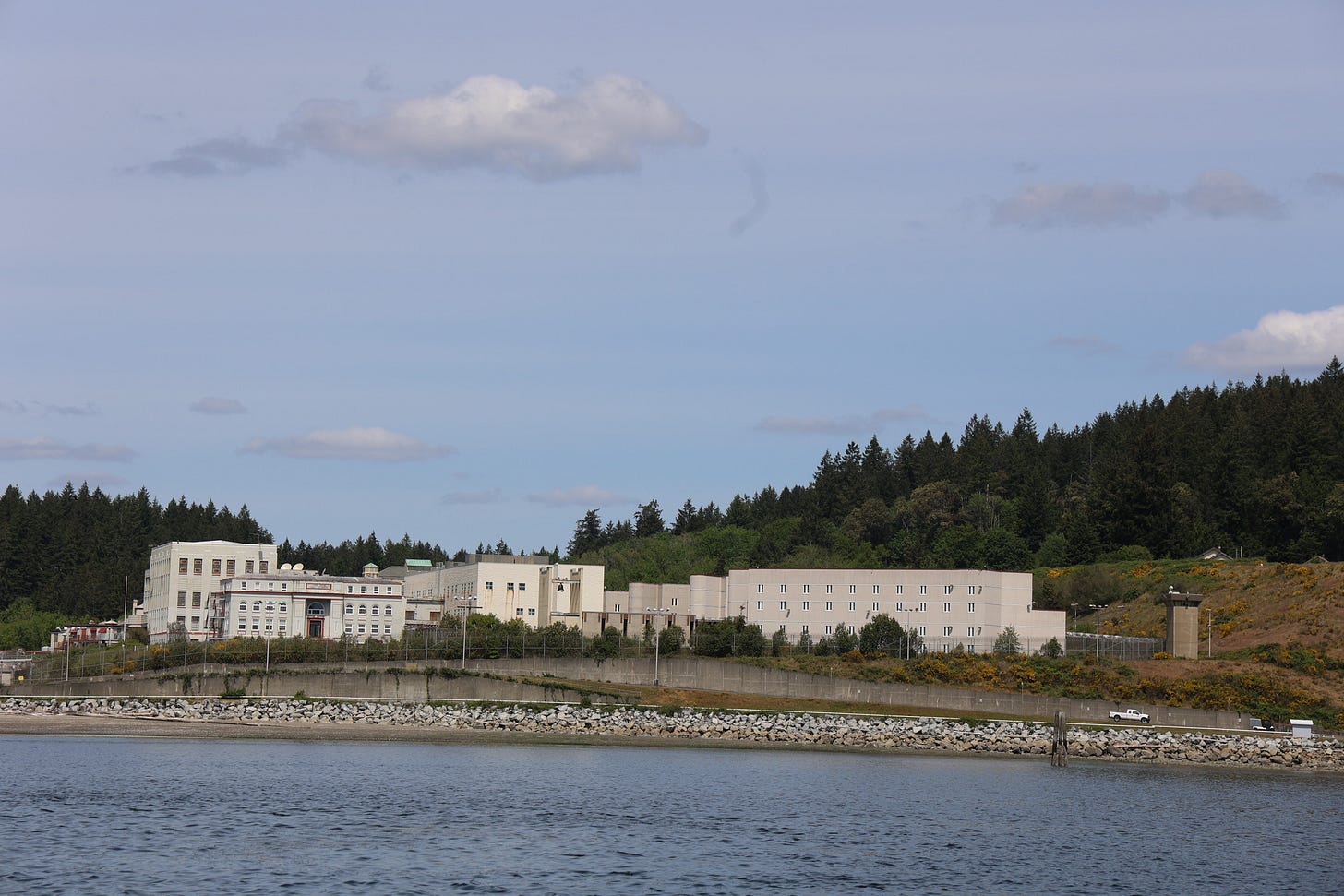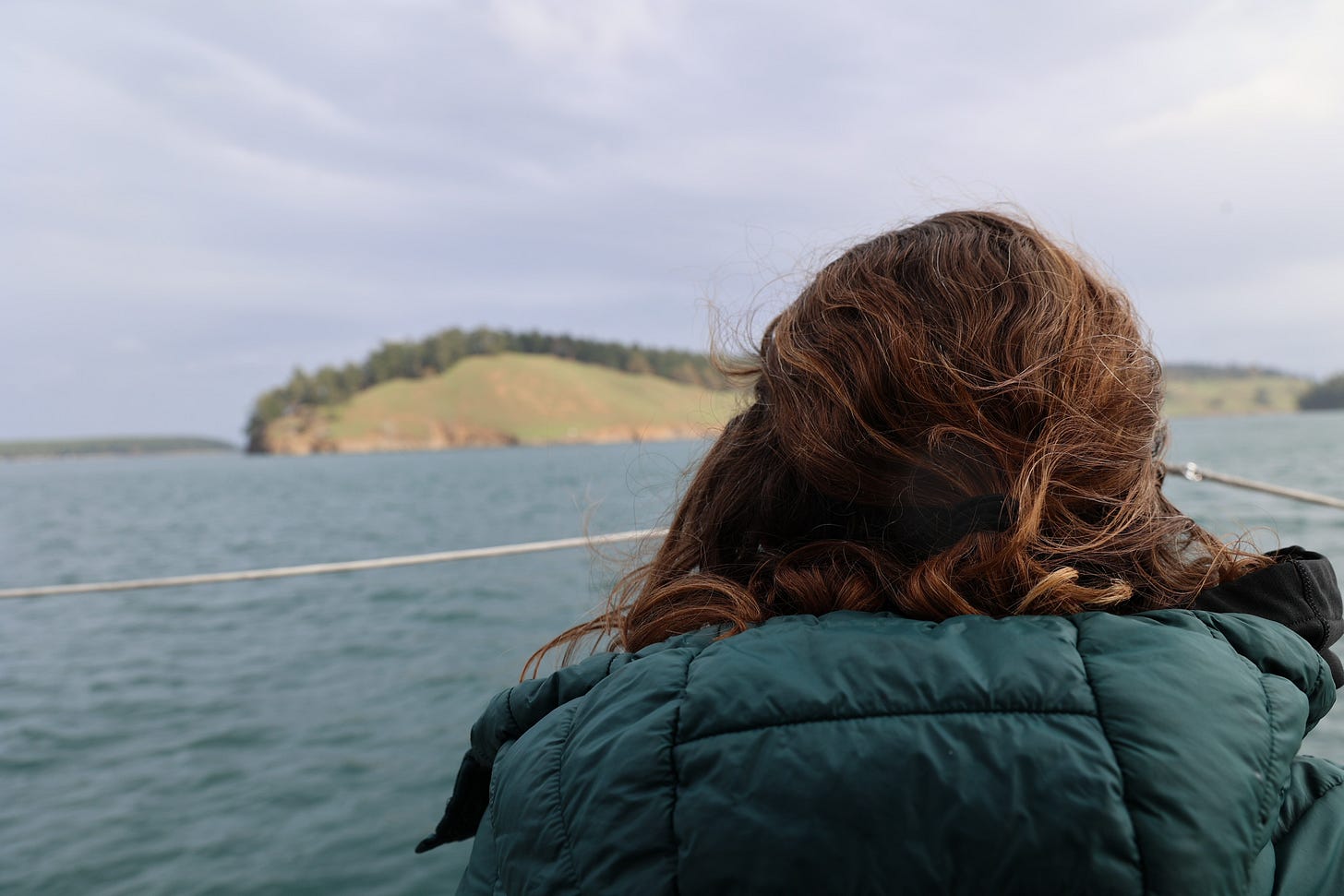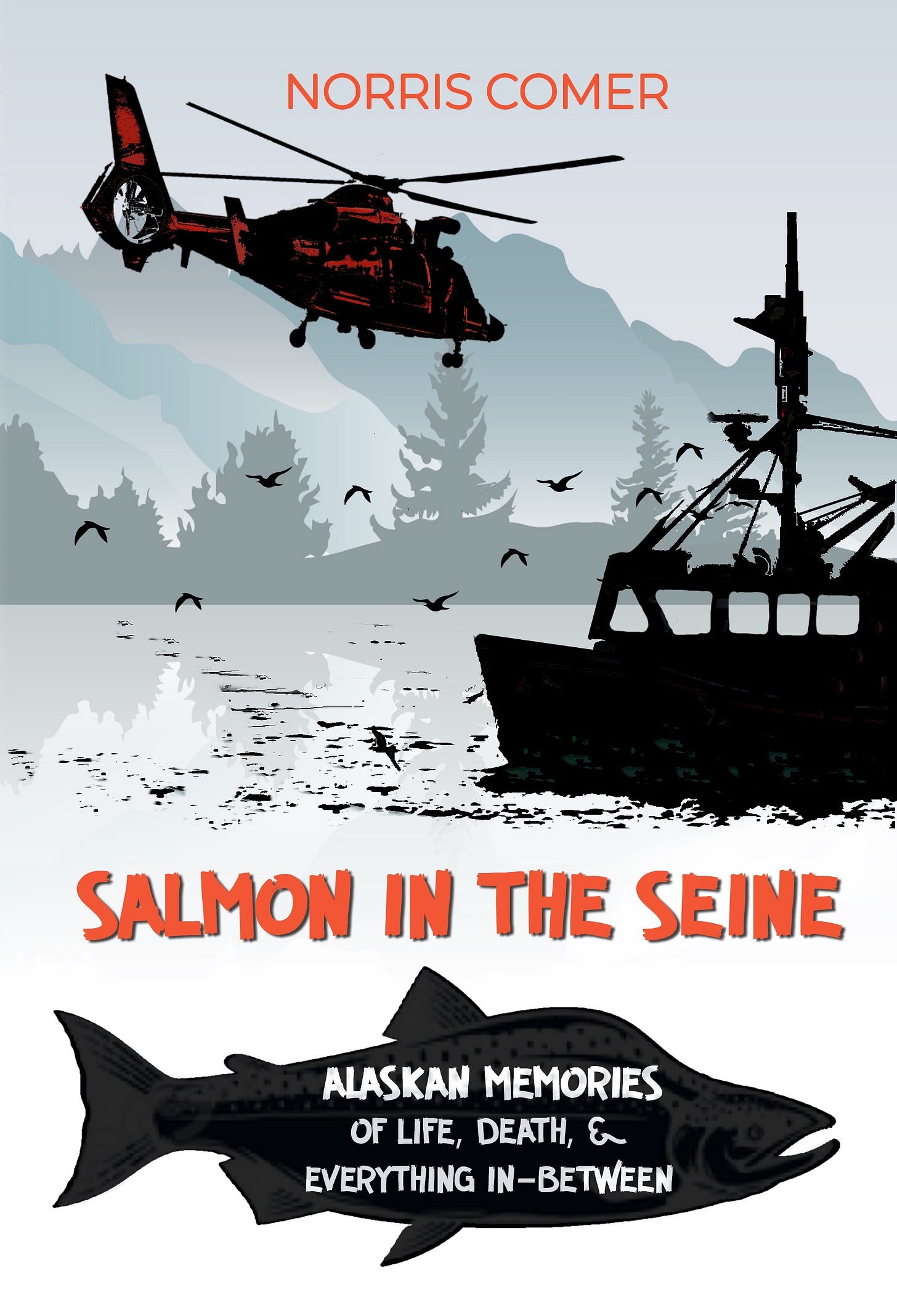I was zipping around on a fast boat in South Puget Sound the other day. This lower half of Puget Sound is an under appreciated cruising ground that’d be the crown jewel of most places throughout the world, but around here you have to compete with the northerly contenders like the San Juan Islands, Olympic Peninsula, British Columbia, and Southeast Alaska. But c’mon, racing toward Mt. Rainier at 35 miles per hour is peak South Sound glory and I’m all for it.
Among the many pleasant moments—that included orcas, sunshine, and a salmon dinner while moored at a state park—was a hushed transit past infamous McNeil Island. What’s the deal with McNeil Island, you may ask? Well, the state administered island holds a detention center for convicts of “violent sexual acts” right on the shore. There are signs along the beach warning passersby to not land. Would the rapists dash out of the forest like a horde of deviant zombies to feast upon a wayward visitor?! The imagination goes wild.
This brief moment on my trip prompted me to think about a less talked-about element of Puget Sound’s islands. Sure, there’s the stuff often written of that draws the crowds of locals and tourists alike. Ferry rides from Seattle to Bainbridge for a stroll down Winslow Way. Bike tours crisscrossing Orcas and Lopez Islands. A B&B stay on Whidbey Island. Yes, these are all there and are as delightful as they sound. But there’s a whole other realm of Puget Sound’s islands that’s, dare I say, darker. Let’s get away from the tourism board brochures for a hot second. Mysterious. Forbidden and inaccessible. The lands of bloodline rights and quietly wealthy and military clearances. Yes, there is a “move along, nothing to see here” element to much of the Puget Sound. Our waters, deep and cold, shelter secrets. America hides her Pacific nuclear submarines here for a reason and our otherworldly giant Pacific octopodes and six-gill shark gatherings are appropriate stewards of the depths.
I offer this piece as a peek at three forbidden Puget Sound islands.
McNeil Island - Refuge for Rapists and Wildlife

McNeil is an approximately 6.6 square mile island in South Puget Sound within a few miles of Tacoma, Washington. The island belonged to the Steilacoom people until the 1840s and was transformed into a federal penitentiary from 1875 to 1981—thereby becoming state run. The state-managed prison closed in 2011 and was the last American island prison that could only be accessed by land or sea. Alcatraz gets all the PR, but McNeil endured. There is a McNeil Island Historical Society that educates and preserves the history of the place. I don’t know anybody who has gone out there to the active rapist detention center to learn this history, although it is interesting. Sphincter clenching, even.
What would draw crowd interest are probably the connections to contemporary criminals. The “Birdman of Alcatraz” Robert Franklin Stroud was on McNeil from 1909 to 1912. Charles Manson was there at one time too. In fact, it seems like McNeil was the nation’s Alcatraz (that opened at a late date in 1934) during the bootlegger years with many of the most infamous, FBI’s #1 public enemy prisoners ending up there in the 1920s/1930s. Reportedly 85 Japanese Americans who resisted the draft to protest their wartime confinement also did time here. Anyone who knows me knows I’m a Tom Robbins fan. The novelist references McNeil prison in his 1980 book Still Life With Woodpecker. Robert De Niro’s character in the movie Heat (1995) also talks about doing time on McNeil.
Now the island is a wildlife refuge with some historical preservation and the Special Commitment Center (SCC) accessed via ferry from Steilacoom, Washington. The SCC indefinitely detains sexually violent predators who’ve completed their standard prison sentences. There are 200-something residents of the island, all prisoners or jailors. Is this beautiful island originally yanked from native peoples really the place for them? Could they live on a scrubby patch of Yakima county for cheaper? That’s your call, dear reader.
Squaxin Island - Native Bloodlines Drama
A mere tenish miles west of McNeil is Squaxin Island, again notable for its “no trespassing” status. This island is a reservation for the Squaxin tribe and is legally their sovereign land. As a curious amateur, I’ll not go anywhere near the intricate history of the tribe and its acquisition of the island. You ought to seek historical experts and full length books for that information. But as an aquatic passerby on the water, it certainly is a notable presence.
Notably breaking this week, there is a mass disenrollment of 43 people of Squaxin tribal membership. Apparently the tribe takes their 1/8th blood requirement very seriously. The Squaxin tribe has about 1,300 members, making it one of the smallest federally recognized tribes in Washington (and probably the country). From King5:
Jamie Queen, who was also disenrolled from the Squaxin Tribe, said she worries most about vulnerable tribal members.
"Elders are cut off their income checks, they're being cut off their treaty rights-- some people lived off that their entire life," Queen said. "They no longer have that. So they're losing their housing, their medical, their income-- their whole source of identity and now they have to reinvent themselves and figure out who they are."
When asked if she still identifies as Squaxin, she said no. "I identify myself as an Indian, to be honest with you," she added.
"If they told me today you are now re-enrolled, I'm going to tell them to shove it up their ass," Queen said. "I don't want to be enrolled. I feel like it is a disrespectful thing to do, honestly, but to make right for me, I want a letter for my son."
Queen said she wants her late son, who is technically still enrolled Squaxin to be officially disenrolled too.
"It's going to leave him hanging over here," Queen said, tearing up. "I have his ashes, but he's still hanging. It's not okay, he's coming with us."
The island itself is silent, but the drama about bloodlines and who has the right to set foot upon it rages. I float on by like a bird on the wind, none the wiser.
Spieden Island - Exotic Beasts and a Sunglass Tycoon

Spieden Island is not South Sound—it’s north among the San Juans. But I just had to mention it because exotic beasts of all sorts have my heart and Spieden is loaded with them. I’ve sailed past a few times. Unbelievably to me, this 516-acre island is completely privately owned. By whom? Our most current public information says James Jannard, founder and major stakeholder of Oakley, Inc. That’s right, those overpriced goddamn sunglasses half the douchebags you know are obsessed with earned this random jagoff one of the dozen or so San Juans Islands of this size in existence. Ain’t this country great? Next you’ll tell me we stole land from the Steilacoom people just to house rapists! Fly the flag and play Taps, I’m feeling patriotic.
In Jannard’s defense, Spieden Island has been a private haunt for generations. The most defining feature for me—besides the striking glacially carved bluffs—are the imported exotic animals. Corsican Mouflon sheep, European fallow deer, and Asiatic Sika deer were all brought in for game hunting in the 1970s/80s. Apparently about 2,000 exotic birds were also imported. The hunting lodge concept is long gone, but the surviving animals from that era endure in a sort of Jurassic Park: Lost World existence. I’ve also seen these Mouflon sheep on nearby Jones Island. Maybe they swam there, maybe locals “imported” them from Spieden. I’m not telling. Site B, baby. Life, myeahs, finds a way.
Consider buying my award-winning book, Salmon in the Seine: Alaskan Memories of Life, Death, & Everything In-Between. Available wherever books are sold. Leaving reviews on Amazon and Goodreads helps a ton too.









This was fascinating and engaging, as always! I never knew anything about these islands.